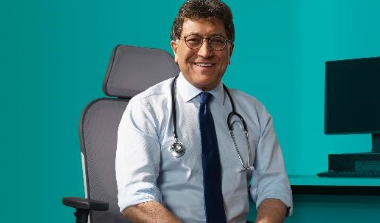Heartburn from Gastro-oesophageal reflux disease (GORD) can be very uncomfortable. The Bravo device can monitor the level of acid for up to three days.
Why you might need it
Heartburn is a very common symptom that can be due to underlying Gastro-oesophageal reflux disease (GORD).
GORD means that the stomach acid can reflux or splash into the gullet (oesophagus). GORD is very common and can affect up to 20% of the population at any given time. GORD can manifest with different symptoms such as regurgitation, chest pain, acidic taste in the mouth and even food sticking in the gullet. Diet and life style changes may result in some improvement but many patients depend on long term use of antacid drugs. Despite this, the symptoms are poorly controlled in many patients, which can lead to complications such as Barretts oesophagus or even cancer of the gullet. GORD is often associated with the presence of a hiatus hernia, when top portion of the stomach is pulled through the diaphragm into the chest.
It is important to determine the severity of GORD which can help us to decide on the need for surgery which, in turn, may prevent complications such as Barretts oesophagus. Previously this required insertion of a tube through the nose into the stomach for 24 hours. Most patients find this uncomfortable. They also struggle to eat, drink and even sleep normally which is vital to obtain accurate data from the patient.
How much does Bravo pH monitoring cost at Spire Clare Park Hospital
We can't display a fee for this procedure just now. Please contact us for a quote.
Who will do it?
Our patients are at the heart of what we do and we want you to be in control of your care. To us, that means you can choose the consultant you want to see, and when you want. They'll be with you every step of the way.
All of our consultants are of the highest calibre and benefit from working in our modern, well-equipped hospitals.
Our consultants have high standards to meet, often holding specialist NHS posts and delivering expertise in complex sub-specialty surgeries. Many of our consultants have international reputations for their research in their specialised field.
Before your treatment
You will have a formal consultation with a healthcare professional. During this time you will be able to explain your medical history, symptoms and raise any concerns that you might have.
We will also discuss with you whether any further diagnostic tests, such as scans or blood tests, are needed. Any additional costs will be discussed before further tests are carried out.
Preparing for your treatment
We've tried to make your experience with us as easy and relaxed as possible.
For more information on visiting hours, our food, what to pack if you're staying with us, parking and all those other important practicalities, please visit our patient information pages.
Our dedicated team will also give you tailored advice to follow in the run up to your visit.
The procedure
The Bravo wireless PH monitoring device is a new technique which is much more patient friendly. During an endoscopy, a small capsule is attached to the lining of the gullet in the lower oesophagus.
As soon as the capsule is attached, it begins measuring the acid levels in the oesophagus. The capsule sends the data wirelessly to a small receiver that patients wear on their belt. Patients are asked to record the periods of eating, drinking and sleeping in a diary throughout the study. They can also press the appropriate buttons on the receiver if they have heartburn, chest pain or regurgitation.
Bravo pH study can measure for 48 or even 96 hours. This is a considerably longer period of recording than the conventional test, so it offers much more robust information.
In addition, the 96hr study allows us to measure the acid levels with and without the use of antacids which can be more informative. At the end of the recording period, patients return the data receiver. The information is analysed using the appropriate software. The capsule detaches from the gullet and passes out by day five in majority of patients.
Aftercare
Depending on the results of the Bravo pH study and the response to medication, some patients may need surgery to treat their condition. Previously patients would have Nissens Fundoplication, where the top part of the stomach is wrapped around the lower oesophagus to improve the reflux barrier.
Nowadays, there is a new anti reflux procedure, called the LINX system. During this procedure a titanium bracelet, made of magnetic beads, is implanted around the lower oesophagus to close the hiatus hernia. It is a keyhole procedure and is much less invasive than the previous surgery. Most patients go home the same or next day. Majority of patients are able to stop their heartburn medications.
Why choose Spire?
We are committed to delivering excellent individual care and customer service across our network of hospitals, clinics and specialist care centres around the UK. Our dedicated and highly trained team aim to achieve consistently excellent results. For us it's more than just treating patients, it's about looking after people.
Important to note
The treatment described on this page may be adapted to meet your individual needs, so it's important to follow your healthcare professional's advice and raise any questions that you may have with them.
How to get to us
Our location between the towns of Farnham and Fleet allows us to provide medical and surgical treatments to patients from Surrey, Hampshire, Berkshire and West Sussex.
Spire Clare Park Hospital,
Crondall Lane
Farnham
Surrey
GU10 5XX



